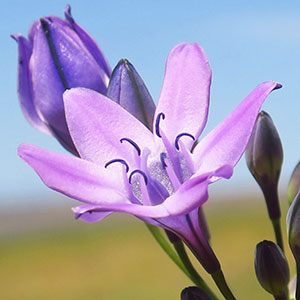Triteleia bridgesii
Triteleia lugens
Bridges' brodiaea, Bridges' triteleia
Coast Range triplet lily, Coast Range triteleia, dark-mouth triteleia
20–55 cm × 3–10 mm.
10–40 cm × 3–10 mm.
10–60 cm, smooth except sometimes scabrous near base.
10–40 cm, smooth.
perianth lilac, bluish purple, pink, or reddish purple, 27–45 mm, tube strongly attenuate with slender base, 17–25 mm, hyaline vescicles present in tube, lobes abruptly spreading, 10–20 mm, shorter than tube;
stamens attached at 1 level, equal;
filaments triangular, widened toward base, 3–4 mm, apical appendages absent;
anthers bluish, 3.5–4.5 mm;
ovary 1/4–1/3 length of stipe;
pedicel 2–9 cm.
perianth pale yellow to golden, 12–15 mm, tube funnelform, rather broad, 4–6 mm, lobes spreading, never rotate, with dark midvein, 6–9 mm;
stamens attached at 1 level, unequal, alternately long and short;
filaments dilated entire length, 1–2 or 2–4 mm, inner filaments equal to lobes, longer filaments rounded apically, apical appendages absent;
anthers yellow or blue, 1.5–2 mm;
ovary equal to or longer than stipe;
pedicel 1–2.5 cm.
= 16.
= 16.
Triteleia bridgesii
Triteleia lugens
Triteleia bridgesii is similar to T. laxa and in herbarium specimens can be distinguished only by the stamens. However, in fresh flowers, the perianth lobes of T. bridgesii spread abruptly from the throat of the perianth tube, unlike those of T. laxa, and the flowers of T. bridgesii are erect, while those of T. laxa are oriented horizontally. Triteleia bridgesii flowers a month earlier than T. laxa where they both occur in the Sierra Nevada foothills. The flowers in specimens of T. bridgesii from Humboldt County are unusually long, which accounts for the wide ranges of measurements for the perianth.
(Discussion copyrighted by Flora of North America; reprinted with permission.)
Triteleia lugens has a disjunct distribution, being found in Lake, Napa, and Solano counties north of San Francisco Bay (with pale yellow flowers), and 140 miles away in Monterey and San Benito counties south of San Francisco Bay (with bright yellow flowers).
(Discussion copyrighted by Flora of North America; reprinted with permission.)


